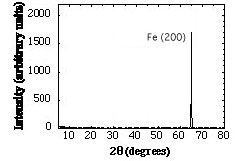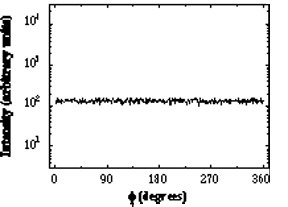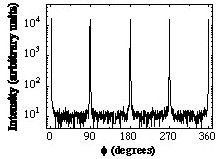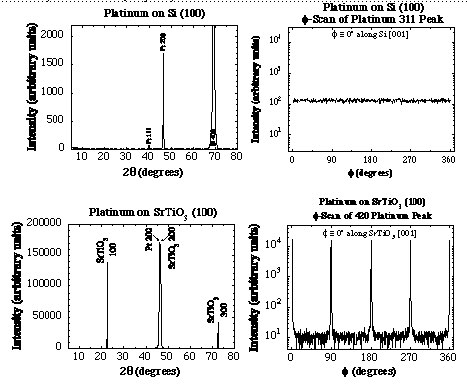
HOMEWORK # 4 - 1998
1. Consider iron flakes that are extended along the (200) plane and thin in the [001] direction. Iron has an easy axis in the [100] direction. If the flakes are dropped onto the flat surface of a specimen holder,
a) Draw the theta-2theta xray diffraction pattern expected.

use a = 2.866 Ang. to get d(200), then Braggs' law to find 2theta. only (200) planes are parallel to specimen surface, so get one peak. (400) peak out of range.
b) Draw the phi-scan of the (110) xray diffraction peak expected.

to detect the (110) peak, the chi angle must be appropriately changed. since the flakes are randomly oriented w/in the plane parallel to the specimen surface, there will be diffracting (110) planes at any phi angle.
If a magnetic field is now applied in the plane of the deposit,
c) Draw the theta-2theta xray diffraction pattern expected.
same as part a.
d) Draw the phi-scan of the (110) xray diffraction peak expected.

now the [100] directions for all the flakes are aligned along the magnetic field, and as phi is rotated, a (110) comes into diffracting position only every 90°. the starting position of these peaks will vary, depending upon the angular relationship between phi = 0° and the magnetic field direction.
the above answer is probably best arrived at by constructing a cardboard (or other) cube, and rotating it thru the appropriate chi and phi angles.
2. The measured theta-2theta and phi-scans for two platinum (F cubic)
thin films are shown below. The first set of plots is for a platinum film
grown on a silicon single crystal and the second set is for a platinum film
grown on a SrTiO3 single crystal.

a) Which film(s) is(are) epitaxial? Why?
Pt on Si is not. the phi scan shows that the distribution of a crystallographic direction in the plane parallel to the surface of the Si wafer is random. also, more than one peak for Pt on the theta-2theta scan.
however, Pt on SrTiO3 is not random as per
the phi scan. thus, epitaxial.
b) For the epitaxial film(s) specify the orientation relationship. Show how you arrived at your answer.
only (h00) reflections for Pt and SrTiO3
on theta-2theta scan. thus, (100) planes for both are parallel.
now need to specify corresponding directions within
the plane of the film. using the model of the cube again, we note that Pt(420)
will reflect at phi = 0° only if a [100] is horizontal or vertical (really
both). this direction, then, must be parallel to SrTiO3(001).